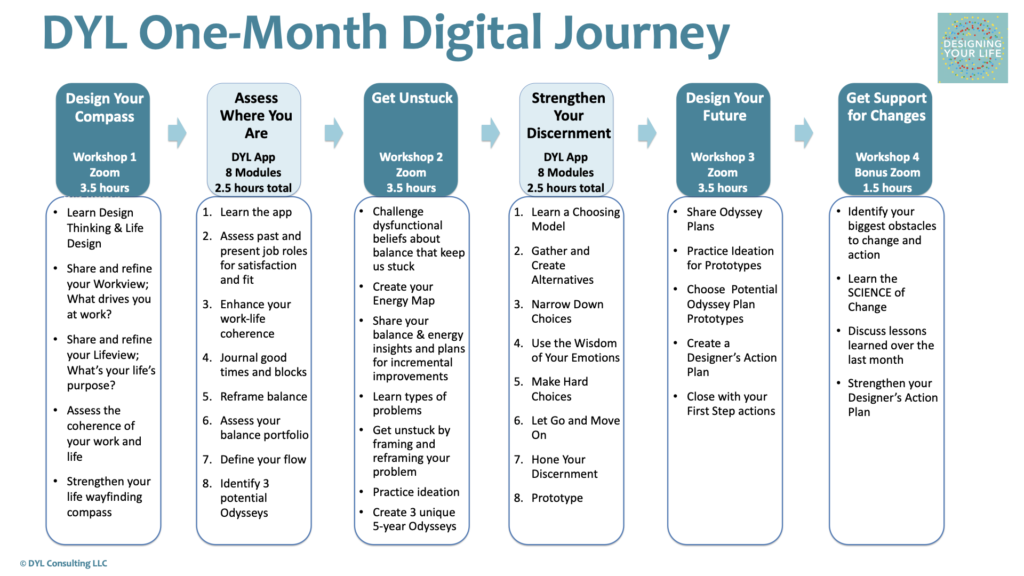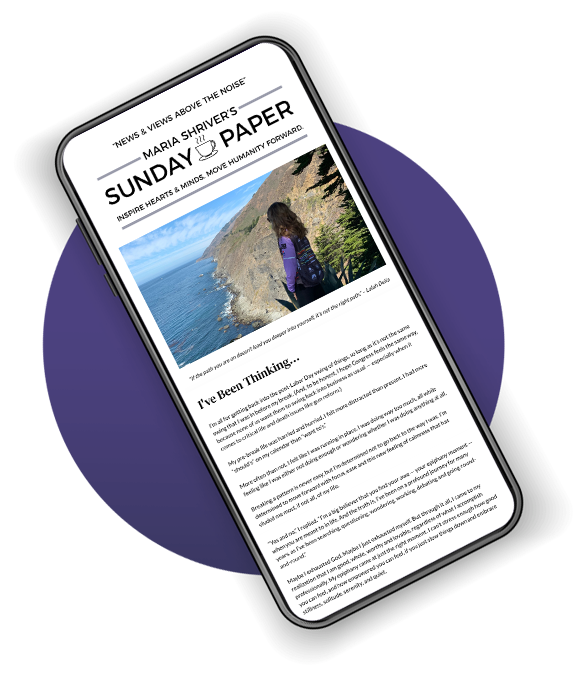Designing Your Life: Where to Start

In times of transition, deciding what we want next and then how to get it can be overwhelming, even terrifying, leaving many of us feeling stuck and paralyzed no matter our age or chapter we’re at in our lives.
That’s where Kathy Davies and Susan Burnett—both former business executives—say “Design Thinking” comes in. Design Thinking is a strategy that helps crack open a problem like a product designer might approach a customer or user-based issue.
By applying this mindset to real-life problems, instead of business products, Susan and Kathy say solutions often appear for problems that at first may seem unsolvable.
It’s a unique and innovative process inspired by the New York Times bestselling book, Designing Your Life: How to Build a Well-Lived, Joyful Life by Bill Burnett and Dave Evans. The book’s success ultimately led to Susan and Kathy’s interactive workshop—Designing Your Life for Women—which they run out of the Stanford Life Design Lab at Stanford University.
We recently spoke to Susan and Kathy about their popular (now virtual) course, how getting “unstuck” can be trickier for women, and why designing a new life with more meaning and purpose doesn’t need to be a solo journey.
A Conversation with Kathy Davies and Susan Burnett
Can you tell us more about “Design Thinking” and who it’s for?
Kathy: Design Thinking [in the business world] is a development process that allows folks to take a very ambiguous and difficult or thorny problem and to tackle it. It’s a great way of building your way forward. [The first step is defining the problem] after which you ideate on possible solutions. Then you take the wide variety of ideas you’ve generated, take a few of them you think are potentially worth something, and build them out further – and that’s prototyping. Then you ask, are we solving the problem we’re hoping to solve?
Essentially, it’s for anyone who is in a space of transition. Anyone who is working on a thorny or difficult problem that can’t be solved by writing a check, that doesn’t have an obvious solution that’s already been done. It may even be a problem that’s evolving as you’re working on it. And right now, I would argue, that’s probably everybody in the world because COVID has shook our lives upside down—and we’re in a place where things are ambiguous, they’re changing often without our consent.
What hurdles do people, particularly women, experience when applying a Designer’s mindset to their lives?
Susan: Women have a lot of fear. There’s a social narrative around what they’re supposed to do and so the first thing we do is talk about social narrative. What are the expectations of society, family, social media? What does a successful woman look like? And that’s important because it’s driving a lot of decisions even if its subconsciously driving them.
So we ask people to really look at their own social narrative. We see a lot of women limited by fear, fear of if they can really make a change, fear of whether they’ll ever be employed again, fear of whether they can actually have work where they thrive or will it always be a drain, fear of never having a family or a partner. Design Thinking helps with these fears because it’s a neutral process. It’s a process that starts with breaking it down to then build your way forward.
Kathy: There are narratives in our society that say you should have it all figured out by a certain age—and we call those dysfunctional beliefs. Essentially, these are narratives that we have running in our subconscious that keep us stuck. One of the things that’s really tough for a lot of folks is just unpacking those narratives and noticing where those narratives are holding them back. That’s what I love about “Design Thinking” and life design—it’s a step-by-step process that can ground us when we’re lost.

How do you know when it’s the right time to design a new life?
Kathy: There’s a process of noticing that one can develop, which is the first step. It’s when you’re paying attention enough to realize, “hey, I’m not all that happy with the way things are going right now.” And then there’s this moment when you decide you’re unhappy enough that you want to make a change. That’s when the Design Thinking process might kick in…when that noticing has reached a level where you’re uncomfortable enough that staying the way you are isn’t going to work anymore.
Susan: There’s something that’s out of equilibrium that gets you to notice what you’ve been doing before isn’t going to serve you going forward and you don’t know what to do. And that’s when people usually find us. For a person who has never heard of [Design Thinking] before, it can be very intriguing. It’s not a self-help class. We don’t say “here are the five things you should do to be happy.” We say, “here’s a process where you can design what you need based on the empathy you have for what’s going on in your life right now.” And it’s different for different people. What satisfies you, may not satisfy me.
Is community an important factor in the Design process?
Susan: Yes, definitely. Women come with a specific concern or problem to solve and then they discover there’s a whole community, people they’ve never met, and they’re all dealing with something in a similar nature. I just talked to a woman who’s in our digital experience right now and she said the biggest thing that has happened is that one, she has tools she can use, but two, she doesn’t feel as alone—like she thought she was going crazy by herself and thought something was wrong with her. Now she realizes everybody is on this journey. She’s okay, she just needs a process and tools to navigate.
Kathy: That feeling of “I’m okay, there’s nothing wrong with me, and I have agency and I have process” is transformative. I would argue that we see it in our women’s program, but we see it in our company programs as well. We see groups of people come together and realize “oh, we are all dealing with challenges.”
This interview has been edited and condensed for clarity. Learn more about the Designing Your Life for Women workshop HERE and sign-up for the next one, which launches in January HERE (early-comers get a discounted rate!).
Kathy Davies is the Managing Director of the Life Design Lab at Stanford University, where she teaches Product Design and life design courses, and shares life design trainings with educators globally. She is also the co-founder of Designing Your Life Consulting and a commercial Master Trainer. Kathy has 15 years of industry experience developing electromechanical and software products, and proudly holds five patents. She consults with Silicon Valley companies, teaches design thinking, conducts ethnographic research, and develops product strategies and concepts. Her prior experience as an engineer and product manager and leader of engineering teams gives her particular skill in understanding and connecting with technical audiences as they learn life design tools. Kathy believes design thinking and life design can empower social change, especially around equity for women.
Susan Burnett is co-founder of Designing Your Life Consulting and a Master Trainer who teaches DYL at Stanford University, in companies and in public retreats. Susan has dedicated the last 40 years of her career to designing for individual and organizational transformation and growth. She held executive leadership roles at Hewlett-Packard, Gap Inc. Deloitte and Yahoo!, where she led large scale business changes, cultural renewal, employee engagement, and leadership development. She also led the effort to build Deloitte University – a center for leadership and culture. Susan believes that by empowering people with the life design process, tools and mindsets we can design new ways to work and live in a chaotic, unpredictable, and ever-changing world. She is a regular speaker, consultant and author.


